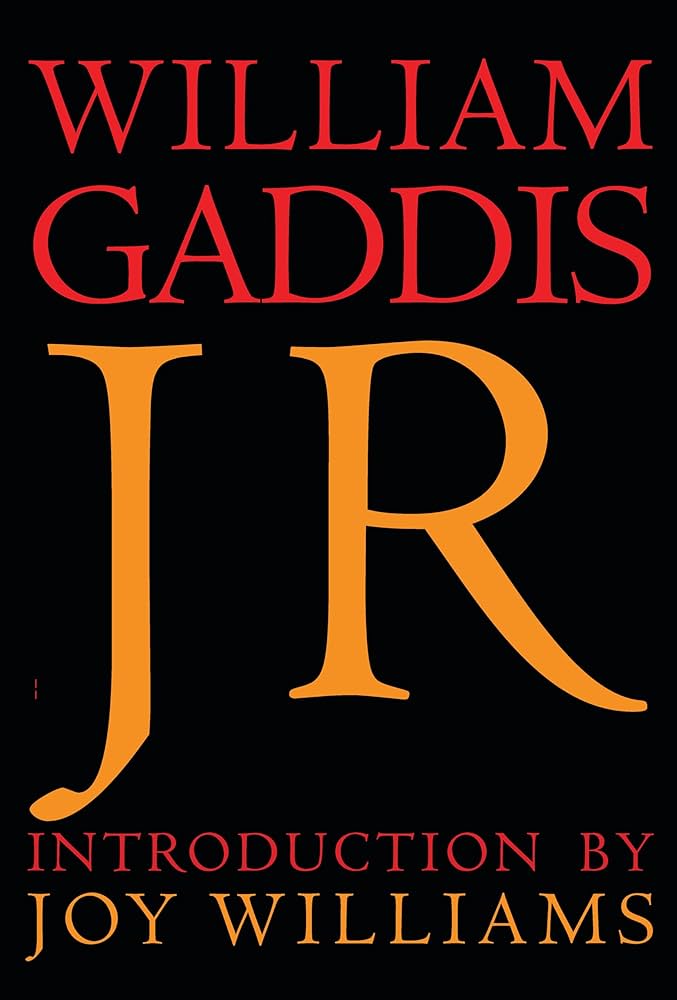We open with Wagner—his Der Ring des Niblungen (The Ring of Niblungen, known as The Ring Cycle).
A cycle of ‘four German-language epic music dramas composed by Richard Wagner.’[1]
Never before have I read a novel with the main character; indeed, the work’s title is represented by their initials – but I find that they hardly appear in the story at all. Or, rather, I was not too sure of when the character of J R was actually in the narrative –
(I did wonder if J R was hidden behind the green curtain of Gaddis’s capitalistic lament to a form of OZ. Follow the yellow-brick road, which leads to nowhere.)
But I was wrong – the characters are revealed, but only through dialogue. I believed I was in a folie à deux with Wiliam T. Gaddis. Madness begets madness, huh?
This is the premise of the entire work: this child-man-boy called J R telephones up companies from the payphone in his elementary school. And organises penny stocks and other deals.
J R Vansant – what a name; he could just as well be an already established tycoon in the prevailing orthodoxy of the era –
The Vansant family. 1930s mansion finished in the Rocco style. Resplendent, rolling, verdant lawns which run for acres. An ornate fountain as you come up the gravel-drive way. (Which is a mile long.) Deer leaping somewhere…
A review by Lee Konstantinou in the Los Angeles Review of Books had a pretty good handle on it from October 28th, 2012 –
‘J R begins amassing his empire after a school trip to the New York Stock Exchange during which his class purchases a share of a company called Diamond Cable, buying what his teacher calls “a share of America.” J R convinces Edward Bast, an aspiring composer whom he meets on the trip, to help him build what becomes the J R Family of Companies. Before the end of the novel, J R has acquired a diverse array of firms — Eagle Mills, Triangle Paper Products, Ray-X, X-L Lithograph, among others — all run out of a hotel suite in Manhattan, managed by a staff that, with the exception of Bast, doesn’t understand they’re working for a child.’ [2]
Scenes in J R seamlessly transition into one another, often without any prior indication, adding to the novel’s unpredictable and captivating structure.
An ambulance may wail going past, and then you glide into another scene where a drunk may be hassling someone on the street. Or onto a roadside where cars stream past, and you enter one of the cars. Randomness. Anarchy in order. A spider amongst the folded, pressed linen of known, domesticated bliss. There is your essay, preposition, and WOOSH! Away to something else. It’s like competing dialogue(s) in an office-work space, not going anywhere but just the juddering, jibber-jabber of chat. Non-sequiturs – the backwash of logic. (To logical-minded folk.)
A radio may be burbling in the school’s office, and there may be a call for a recess. Then, outside the school, a car comes down the road, and a conversation occurs between the two characters in the car. And off we go on that tangent.
‘Much of the novel takes place in a desolate, nightmarish version of Massapequa, New York and features a ludicrously dysfunctional school board. Gaddis, who in real life spent many years in Massapequa and had much of his property seized (using eminent domain) by the school board there, said, half in jest, that he “wrote J R in revenge against Massapequa.”’ [3]
There is a business built on paper—toilet paper. Play it out further: Money. Moolah. Spondulicks. Paper to wipe your backside with if you are rich enough, spark cigars with, and count out dollar bills as if they were Monopoly money.
There are many scenes on train station platforms, chats in train cars and stops, and people asking for tickets or change.
Mr Edward Bast – J R’s music teacher, for me, is the main character of the novel. He carries the heavy lifting.
The oven is his office drawer, where he stores papers there.
One might suppose that the ‘cold-water’ flat was a template inspired by Gaddis’s experience living in a tiny apartment in New York.
There’s a knock on the door. Many knocks on the door. Deliveries come—many deliveries.
The sink overflows.
There’s a young woman always running and in the bath.
Predicated on what? I have no idea.
The studio. Affairs. I didn’t care for these sections.
There are domestic affairs, night scenes, car scenes, and blended scenes of different scenarios, situations, and characters—an assemblage, an assortment. Gaddis focuses on the decline of things in life—entropy.
There are plots upon plots, like fleas upon dogs and mites upon fleas, and on and on it goes.
There is War, the American government, and who J R is dealing with for his deals, phone calls, and more deals.
Was Gaddis saying that the yellow-brick road to that plateau of modern capitalism, which is never really reached, is happiness through monetary gain? Or is it just really a monolithic façade?
I think so.
Reading J R was a literary experience and a life event.
I was not entirely clear when JR was talking in the scene. He is not described, and it is not clear when a character is on stage, as it were. This is the only downside to the work. I feel.
I see The Recognitions and J R as a duo of Japanese red-crowned cranes, the birds, in a literary bind, a dance in literary fields, for the covers more than anything. Published by the New York Review Books, Classics. Yes, my frontal lobe is that shallow.
I will probably have to read JR again. In fact, I know I do.
N
[1] https://en.wikipedia.org/wiki/Der_Ring_des_Nibelungen
[2] https://lareviewofbooks.org/article/too-big-to-succeed-on-william-gaddiss-j-r/
